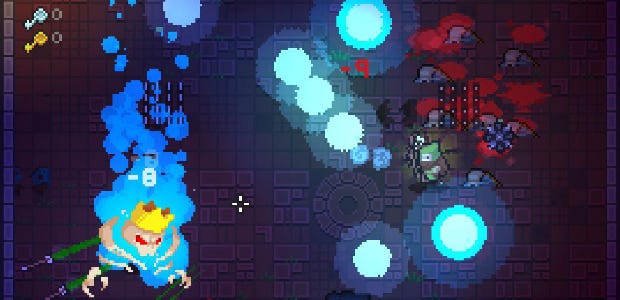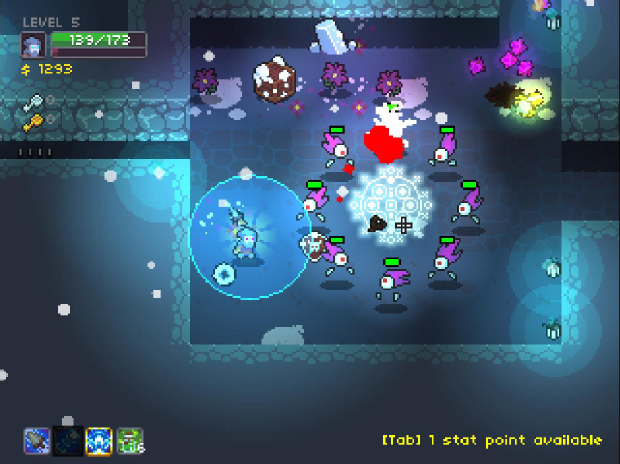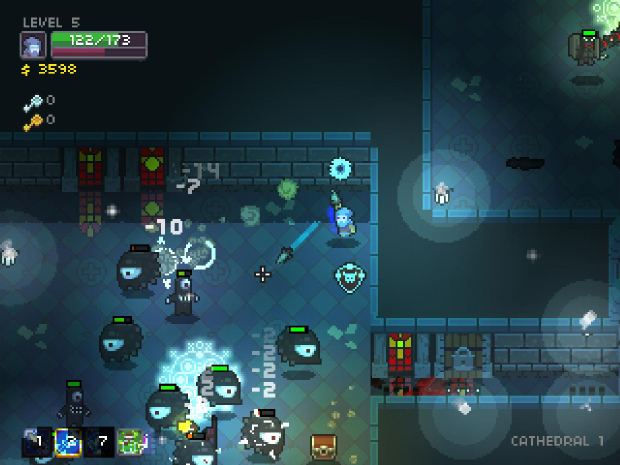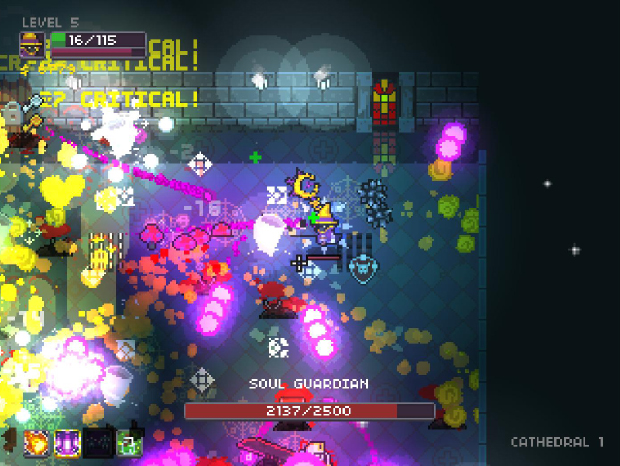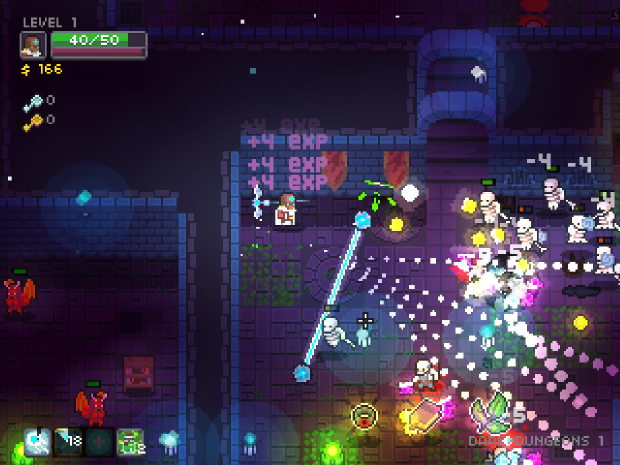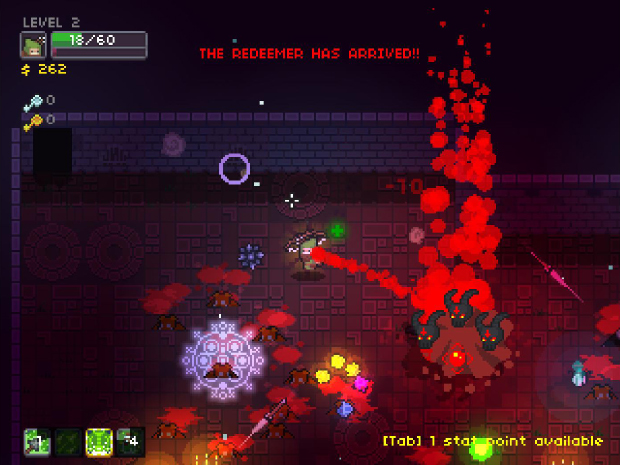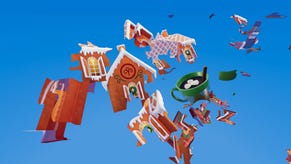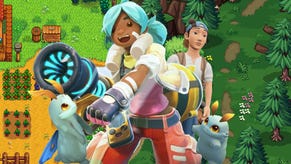Premature Evaluation: Dungeon Souls
Judgement crawl
Each week Marsh Davies wriggles free of his shackles and flees, filthy and naked, from the dank imprisonment of Early Access, bringing you stories of the depravities he endured therein. This week he’s playing Dungeon Souls, a frenetic top-down roguelike in which the player battles through successive tiers of peril, nipping between abruptly spawning enemies and hails of magic bullets.
Titan Souls, Twin Souls, Crystal Souls, Crossing Souls... if Namco ever wanted to stake a claim to that “Souls” suffix, I suspect the horse has bolted, flown to Belize and can now be seen scooting round Tranquility Bay on a jetski, trying to clasp a piña colada between its hooves. But whereas the lack of opposable thumbs ultimately renders this a tragic scene, the existence of Dungeon Souls should be one of celebration, derivative though it is, both in its name and in its action - which borrows heavily from both Nuclear Throne and Spelunky.
Picking one of six starting classes, the player sets out adventuring through procedurally organised catacombs, the exit of each stage unlocking only when a certain number of runes have been located and activated. This is done by standing upon them, which also has the side-effect of spawning a circle of enemies around you. Exactly which monsters materialise from the ether varies - skeletons or bats in the early crypt levels; slimes or beetles in the sewers; laser-eyes in the tundra; even-more-lasery-eyes in the cathedral. Generally these are not the most formidable foes you will encounter, and most classes have some handy AOE skills which can be deployed to clear the room, but the need to explore and overcome these regular rune challenges creates a structure and pace to your dungeoneering, ratcheting up the chaos as you go from combatting single enemies to frantic crowd control amid a cat’s-cradle of laser beams.
Enemies also spawn and respawn randomly throughout the level, making the task of getting back to the exit, should you find that first, a lively challenge. The mixed bestiary ensures a need for rapid tactical adaptation: the legions of undead will mob you; grinning cyclopean sausage-men scuttle in halting movements; necromancers summon more minions unless dealt with swiftly; demons, laser-eyes, archers and sentry turrets all whittle you down with pot-shots; indestructible statues sweep after you inexorably; yetis ball up and roll unpredictably; hulking horned brutes shuffle forward to deal out horrendous damage up close. Occasionally they spawn right beside you, hit you and kill you instantly - one of a few things I might suggest tweaking during the game’s stay in Early Access.
Another would be boulder traps, which are only indicated by a rarely-audible click after they’ve been triggered, and are also frequently unavoidable and entirely lethal. Please do let these fuck right off. Otherwise, however, Dungeon Souls offers a very well-considered challenge, the intense aggression of enemies neatly parried by the repertoire of devastating skills at the player’s disposal, not to mention the various buffs and lurid powers that can be acquired while exploring. Each class has a basic attack and two additional skills with longer cooldowns, which can be switched between by tapping Q and activated with the right mouse button. Healing potions are on F and fresh supplies of these frequently need to be scooped from the floor by hitting the spacebar. With free-aim controlled by the mouse pointer and movement on WASD, each battle requires your left-hand to go full Michael Flatley on the keyboard as you weave between enemy projectiles, return fire, snatch loot and alternate between your deadlier skills.
The consensus seems to be that range classes currently have a much, much easier time of it. (Though there is one guy on the Dungeon Souls’ Community Hub eager to let everyone know that he beat the game three times in a row on his first try, playing as the melee warrior class - bless him!) The warrior and barbarian classes do have the advantage of being able to block incoming projectiles with their weapons, but still end up exchanging damage in a fray, which, even with their larger healthpools, generally means death on the hardest difficulty. Against the bosses, which punctuate each themed section, this is especially tough. Though the Barbarian has one projectile skill - an explosive missile that chains damage to nearby enemies - and a devastatingly fast berzerker mode, the cooldowns are such that you still have to rely on your regular melee attacks. These leave you painfully vulnerable to the bosses’ periodic un-telegraphed guffs of magic projectiles. The Warrior, meanwhile, might be better suited to a career as a Tai Chi instructor, so languorous are the swings of her blade. A broad but impotent AOE attack is paired with a wide-bore mid-range blast - the latter being the only thing which really puts out any considerable damage.
It’s possible that these classes are balanced in a way I have yet to detect - perhaps they more rapidly gain XP or loot, and so offer better power scaling - but I’ve yet to make it far enough with them to find out. So far, I’ve performed best with the Thief, Wizard and Archer classes, roughly in that descending order. The Thief is the speediest class - no small boon when nipping between incoming projectiles - pin-cushioning enemies with reasonably accurate volleys of knives, lobbing bombs and turning invisible at will, so mitigating the small health pool by simply being hard to hit. The Wizard’s basic flurry of fireballs is deadly enough, but her primary skill sends out waves of detonations from her in eight directions, and recharges pretty promptly, making clearing rune-spawns something of a doddle. Her secondary skill is a clone, to which you can later teleport at a click, but I’ve not found this hugely useful as you can’t guarantee you aren’t teleporting back into some freshly spawned nightmare. The Archer, meanwhile, can activate a buff which quintuples his shots for a number of seconds or designate an area some distance away to receive a rain of arrows.
The final class, the Cleric, promises to be the most technical, being tied intently to the player’s positioning. His ranged spells are slow firing, but bounce, and his primary skill is to place a magical barrier which multiplies and spreads his shots as they pass through it. It changes how you think about the spaces in which you fight, looking for surfaces at just the right angle to ricochet projectiles into enemies from relative safety, or placing barriers to concentrate your fire against the anticipated bulk of your foe. His secondary skill is to heal, but I’ve nonetheless found him a challenge to play effectively, particularly in boss fights or against enemies who move rapidly, rendering the tactical benefits of your magic barriers completely null.
That’s not really a complaint, however: the weaknesses of each class make them just as interesting to play as do their strengths, even if the exact distribution of these is currently a little uneven. Items do allow you to partly redress the balance, and by the time you face down the final boss, you are likely to have amassed quite a collection of trinkets: floating laser-firing eyeballs, orbiting spikeballs and shields, and the ability to parp out miniature tornados. There’s levelling to be done too, and, because items can be bought from traders with the gems acquired from popping enemies, it’s to your advantage to spend as long as possible in each level. At some point, however, The Redeemer will arrive - not unlike Spelunky’s ghost - and chase you from the level.
Is that one inspiration too far? Dungeon Souls makes no bones about that extent to which it borrows from its forebears, but, in its particular arrangement of classes, does offer a distinct tactical flavour of its own. And this, I hope, is just the start. More classes, abilities, levels and enemies are promised - and multiplayer, too - though details are vague as to how this will work. I’d like to be able to exert a greater degree of choice over how I build a character class up, with more opportunities to level and spec out. Currently, though the randomness of item drops maintains variety, there are few reasons to think twice about picking anything up, and not that many skill-points to transform your build across the course of a single playthrough.
Most of all, though, I want Dungeon Souls to evolve to express even greater difference from Nuclear Throne than it currently does. It’s splashy, frantic and hugely enjoyable, and its classes are constructed with smart consideration of their asymmetry - all this evident talent deserves to step out from the shadow of its inspirations, to ensure it finds a better accolade than an above-par appropriation of someone else’s poorly secured IP. After all, “WATERSPORT DEATH HORSE WAS DRUNK, SAYS CORONER” is a headline no one wants to read.
Dungeon Souls is available from Steam for £7. I played Update 1 on 09/07/2015.
